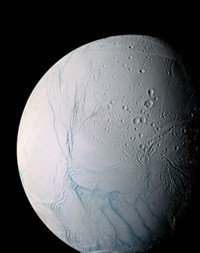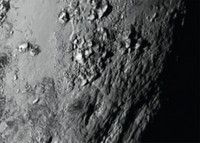Advertisement
Grab your lab coat. Let's get started
Welcome!
Welcome!
Create an account below to get 6 C&EN articles per month, receive newsletters and more - all free.
It seems this is your first time logging in online. Please enter the following information to continue.
As an ACS member you automatically get access to this site. All we need is few more details to create your reading experience.
Not you? Sign in with a different account.
Not you? Sign in with a different account.
ERROR 1
ERROR 1
ERROR 2
ERROR 2
ERROR 2
ERROR 2
ERROR 2
Password and Confirm password must match.
If you have an ACS member number, please enter it here so we can link this account to your membership. (optional)
ERROR 2
ACS values your privacy. By submitting your information, you are gaining access to C&EN and subscribing to our weekly newsletter. We use the information you provide to make your reading experience better, and we will never sell your data to third party members.
Physical Chemistry
Mars's Watery Mysteries
Debate over history of water on the red planet intensifies with new spacecraft data
by Elizabeth K. Wilson
December 1, 2008
| A version of this story appeared in
Volume 86, Issue 48

EVIDENCE IS ABUNDANT that water once flowed on Mars, from widespread deep trenches and gullies carved by great outpourings to the water-linked sediments and minerals impregnating the planet's surface.
In fact, there still is a large quantity of water on Mars. It's there in the polar ice caps and in a planetary blanket of permafrost. And as scientists have just discovered, it's also present in the form of dust-covered glaciers at Mars's mid-latitudes.
But the numerous satellites and landers that humans have sent to Mars in the past two decades still haven't answered the question that most intrigues astrobiologists: Was, and is, liquid water present on Mars long enough to support life?
Two rovers, and the Phoenix Lander , all from the National Aeronautics & Space Administration, have examined martian soil, while a collection of orbiters, including NASA's Mars Reconnaissance Orbiter (MRO), which has unparalleled resolving powers, have mapped the surface in detail. These missions have yielded a trove of new evidence for the involvement of water in Mars's history.
The definitive knowledge still eluding scientists involves determining if water pooled on the surface in the form of long-lived lakes and oceans, or if water flows were short-lived and episodic, as well as whether liquid water still exists under Mars's surface.
Scientists have been able to piece together some of the major elements of Mars's history. Like the rest of its planetary neighbors, Mars formed about 4.6 billion years ago from dust swirling around the new sun. The planet's original water supply may have come from several sources—from the accreting material or from comets, for example.
During the early part of the planet's history, from its formation until about 3.5 billion years ago, known as the Noachian period, water appears to have gushed plentifully over the surface. The Hesperian period saw intense volcanic activity and lasted until about 2 billion years ago.
During the most recent period, the Amazonian, which continues today, Mars has closely resembled some areas of the Antarctic on Earth: barren, cold, and dry. Mars's thin atmosphere of carbon dioxide provides little warmth.
There the historical certainties end. The tight-knit community of Mars scientists continues to wrangle over the nature of Mars's past climate as more complex information streams in from spacecraft. A number of recent reports support the provocative notion that Mars at one point was a hospitable place for organisms to live.
Until recently, scientists were aware of two classes of minerals on Mars that are generally formed in the presence of water: phyllosilicates, which were likely created during Mars's Noachian period, and sulfates, which were likely formed later. Now, MRO has found new evidence for a third water-bearing mineral, opaline silica, over large swaths of martian terrain (Geology 2008, 36, 847).
"There have been more and more pieces of evidence that collectively point to a wet past on early Mars."
ALL THESE MINERALS take thousands, even millions, of years to form, notes Bethany L. Ehlmann, a geological sciences graduate student in the lab of James W. Head III, at Brown University. "To me, that's definitive evidence that water had to be around for a significant amount of time," she says.
MRO's gamma ray spectrometer has delivered new evidence that oceans may have existed on ancient Mars. The instrument measured higher concentrations of potassium, thorium, and iron within the perimeter of what are believed to be old shorelines. The report will be published in an upcoming special issue of Planetary & Space Science. "There have been more and more pieces of evidence that collectively point to a wet past on early Mars," says James M. Dohm, a planetary scientist at the University of Arizona and lead author of the paper.
The Phoenix Lander—which spent five months sampling and analyzing martian soil before the encroaching martian winter ended the mission last month—has provided some interesting twists to the story. Although the soil is now dry and icy at Phoenix's landing site in Mars's north polar region, the lander found calcium carbonate, which is associated with water. It also detected perchlorate ions (C&EN, Aug. 11, page 13) and for the first time measured the soil pH, which was between 8 and 9 (C&EN Online Latest News, June 27). Both of those characteristics are not inhospitable to life, notes Peter Smith of the University of Arizona, and a principal investigator for the Phoenix mission.
But a substantial group of scientists supports a different idea—that Mars has almost always been cold and dry. The outpourings of liquid water that altered Mars's surface were periodic, long enough to carve out geological formations but not long enough to support life, they say.
A team led by Philip R. Christensen, a planetary scientist at the University of Arizona, discovered large patches of the mineral olivine, which should have been weathered away in the presence of water. That supports the periodic water flow hypothesis, he says. One hypothesis holds that periodic asteroid impacts generated enough heat to melt ice and cause occasional copious water flows.

The compelling evidence for these different scenarios can make it difficult to pick a side. "I waffle back and forth," says Ralph Milliken, a planetary scientist at NASA's Jet Propulsion Laboratory, in Pasadena, Calif., and lead author of the Geology paper. "The idea of having an ocean on ancient Mars is certainly very intriguing, but it's hard to convince yourself there actually was an ocean."
Scientists also speculate about whether liquid water currently exists underground. In 2005, MRO reexamined a gully mapped by the Mars Surveyor spacecraft in 2001 and saw what appeared to be a new outflow, possibly of water. The observation generated great excitement, but more recent analyses indicate the flow may be just a landslide. The jury is still out, Christensen says.
ADDING TO the complexity is the recent MRO discovery by geophysicist John W. Holt of the University of Texas, Austin, with Head's group and others, that massive lumpy features in the mid-latitudes of Mars are actually glaciers and that these may contain as much ice as a martian polar ice cap (Science 2008, 322, 1235). "It's a huge reservoir we'll have to account for in models," Head says. "We'll have to account for less ice leaving the planet than we thought."
Scientists are looking to future missions to clarify the picture. NASA has just announced four candidate landing sites, focusing on regions where water-bearing clays lie, for a new rover mission, the Mars Science Laboratory, scheduled for launch in 2009. But the best chance for answering these questions, scientists say, will be a mission to bring martian soil samples back to Earth.
"We 'cold, dry Mars-ers' think the probability that life on Mars could get started is very low, whereas others say it's highly likely," Christensen notes. "The reality is probably somewhere in between."





Join the conversation
Contact the reporter
Submit a Letter to the Editor for publication
Engage with us on Twitter